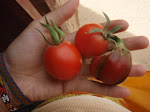Photo by Andy, the HoboTraveler
8/10/08Following a series of meetings in May and July, the village women decided that a grain bank is their hearts' desire, and they asked me to make it happen.* SO: slowly but surely, I've been figuring out what a grain bank is, how it works, and how to procure all the bits and pieces to make it successful. I still have more questions than answers, but I'm hopeful that eventually everything will fall into place. The basics of a GB look like this: an entity of people (in this case, 212 women) obtain a whole bunch of grain (in this case millet), either through their own purchasing power, donated grain or money, or a combo of both (in this case, it'll be a combo). The grain is ideally purchased right after harvest time, when prices are lowest, and then it's stored for much of the year until people's personal stores run out. At that time, the grain is sold out at a higher price than its original purchase, but lower than the current market price (which is often twice the price than that after harvest, so lots of room for profit). The aim of the whole thing is twofold:
1. To increase food security by selling grain at lower costs during the hunger season.
2. To turn a profit for the bank and its members. Profits can be divided among the original investors (the women), or put towards a communally beneficial project (our neighboring village used last year's profits to fund women's literacy classes for 4 months). Or, along with the rest of the sales money, it can be used to re-stock the bank when grain prices are low again.
That is my very rudimentary understanding of the mechanics-- it seems rather straightforward, but I can't help but wonder if there's a lot of room for confusion. I have a few (actually a lot) of questions: mainly, what is the best way for a group of illiterate women to keep accurate records of sales/investments/purchase/profit? I believe it can be done, but I don't know how. There are a couple of literate women in the group, but I am not sure what their actual level of literacy is. The village women are vehemently opposed to admitting any men into the deal, and I wouldn't dream of arguing this point. It is very important to them! They say that the men will 'cinye' all of their money (eat it up!). I suspect that one of the village men (most of whom have at least a few years of schooling and can read at a basic level) might really benefit the accounting/record-keeping aspect of the bank, but I am willing to suspend any doubt and trust the women to give it a run sans-man. Certainly this has been done before, right? Somewhere? I know that grain banks are a common project that PCVs work on in many countries, but I've been surprised at how little information I can find that explains strategies for making them really great. Perhaps it is my American perspective that places so much value on organization and transparent record keeping, and maybe that's simply not the most important thing here. But I worry about the longer-term sustainability of the bank if, for example, not enough money is reinvested to restock it, or if profits aren't distributed evenly, etc.
I hope that a lot of my questions will be addressed, and with luck answered, soon...here's why...upon informing Moussa (the PC Konni region project manager/driver/heaven-sent development agent who gives me little bags of frozen tamarind juice when I visit his family in Konni) about the bank project, he laid out a few steps for me to follow. First, hold a few more meetings with the women to choose 12 representatives to make up the official 'board' of the bank. Then, take those names (and some cash) to the commune's mayor's office (kind of like the governor of an area the size of your average county in the US), to obtain an official Certificate for the bank. Having a board and a certificate somehow legitimizes the bank and puts it on the map (although honestly we did nothing to merit 'Certification' besides gather on a Friday afternoon and shout out the names of the 12 oldest and most influential ladies in town.) The board thing makes sense, of course, even if the picking of the women seemed more political than practical. Next step- organize and hold a training on grain bank management-- YES! So true! Sooo important! And this is the step that we're on right now.
*Do you want an update on this grain bank project?









3 comments:
-tried to post this once, but my internet connection went out, so not sure if it went through-
this entry is one of the most interesting--especially since i'm studying orgs in South America. I'm so glad that Jessica is finding a way to help the women do what they want to do. Nothing will go off without problems, but I am very sure that this experience will prove to be a positive one for the women and Jessica. Please pass along my well-wishes!!
Beth
Hey Jessica, I am enjoying you Kaylee and Brett's Blogs, and enjoyed your journey with the grain bank, i hope it all works out, good luck!
Leanne
Thank you for your comments, Beth and Leanne. This journey with the grain bank is likely to be a challenge. If anybody out there is familiar with literature on setting up successful cooperatives in a predominantly illiterate group, please leave a comment or email me at blissker@gmail.com. For the time being Jessica has to abide by this advice:
"Caminante, no hay camino, se hace camino al andar." ("Traveler, there is no way. The way is made by walking.)
Post a Comment